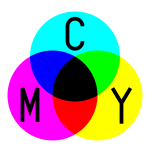The CMYK color model (process color, four color) is a subtractive color model, used in color printing, and is also used to describe the printing process itself. CMYK refers to the four inks used in some color printing: cyan, magenta, yellow, and key (black). Though it varies by print house, press operator, press manufacturer, and press run, ink is typically applied in the order of the abbreviation.
The "K" in CMYK stands for key since in four-color printing cyan, magenta, and yellow printing plates are carefully keyedor aligned with the key of the black key plate. Some sources suggest that the "K" in CMYK comes from the last letter in "black" and was chosen because B already means blue. However, this explanation, although useful as a mnemonic, is incorrect.
The CMYK model works by partially or entirely masking colors on a lighter, usually white, background. The ink reduces the light that would otherwise be reflected. Such a model is called subtractive because inks "subtract" brightness from white.
In additive color models such as RGB, white is the "additive" combination of all primary colored lights, while black is the absence of light. In the CMYK model, it is the opposite: white is the natural color of the paper or other background, while black results from a full combination of colored inks. To save money on ink, and to produce deeper black tones, unsaturated and dark colors are produced by using black ink instead of the combination of cyan, magenta and yellow.
Halftoning
With CMYK printing, halftoning (also called screening) allows for less than full saturation of the primary colors; tiny dots of each primary color are printed in a pattern small enough that human beings perceive a solid color. Magenta printed with a 20% halftone, for example, produces a pink color, because the eye perceives the tiny magenta dots on the large white paper as lighter and less saturated than the color of pure magenta ink.
Screen angle
To improve print quality and reduce moiré patterns, the screen for each color is set at a different angle. While the angles depend on how many colors are used and the preference of the press operator, typical CMYK process printing uses any of the following screen angles.
Benefits of using black ink
Image separated for printing.
The "black" generated by mixing commercially practical cyan, magenta and yellow inks is unsatisfactory, so four-color printing uses black ink in addition to the subtractive primaries. Common reasons for using black ink include:
1) In traditional preparation of color separations, a red keyline on the black line art marked the outline of solid or tint color areas. In some cases a black keyline was used when it served as both a color indicator and an outline to be printed in black. Because usually the black plate contained the keyline, the K in CMYK represents the keyline or black plate, also sometimes called the key plate.
2) Text is typically printed in black and includes fine detail (such as serifs), so to reproduce text or other finely detailed outlines using three inks without slight blurring would require impractically accurate registration.
3) A combination of 100% cyan, magenta, and yellow inks soaks the paper with ink, making it slower to dry, and sometimes impractically so. This also can cause the ink to bleed.
4) Although a combination of 100% cyan, magenta, and yellow inks should, in theory, completely absorb the entire visible spectrum of light and produce a perfect black, practical inks fall short of their ideal characteristics and the result is actually a dark muddy color that does not quite appear black. Adding black ink absorbs more light and yields much better blacks.
5) Using black ink is less expensive than using the corresponding amounts of colored inks.
When a very dark area is desirable, a colored or gray CMY "bedding" is applied first, then a full black layer is applied on top, making a rich, deep black; this is called rich black. A black made with just CMY inks is sometimes called a composite black or process black.
The amount of black to use to replace amounts of the other ink is variable, and the choice depends on the technology, paper and ink in use. Processes called under color removal, under color addition, and gray component replacement are used to decide on the final mix; different CMYK recipes will be used depending on the printing task.
Link







No comments:
Post a Comment